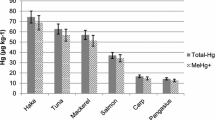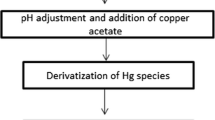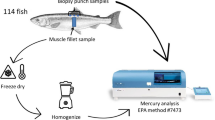Abstract
Multiple treatment (i.e., drying, chemical digestion, and oxidation) steps are often required during preparation of biological matrices for quantitative analysis of mercury; these multiple steps could potentially lead to systematic errors and poor recovery of the analyte. In this study, the Direct Mercury Analyzer (Milestone Inc., Monroe, CT) was utilized to measure total mercury in fish tissue by integrating steps of drying, sample combustion and gold sequestration with successive identification using atomic absorption spectrometry. We also evaluated the differences between the mercury concentrations found in samples that were homogenized and samples with no preparation. These results were confirmed with cold vapor atomic absorbance and fluorescence spectrometric methods of analysis. Finally, total mercury in wild captured largemouth bass (n = 20) were assessed using the Direct Mercury Analyzer to examine internal variability between mercury concentrations in muscle, liver and brain organs. Direct analysis of total mercury measured in muscle tissue was strongly correlated with muscle tissue that was homogenized before analysis (r = 0.81, p < 0.0001). Additionally, results using this integrated method compared favorably (p < 0.05) with conventional cold vapor spectrometry with atomic absorbance and fluorescence detection methods. Mercury concentrations in brain were significantly lower than concentrations in muscle (p < 0.001) and liver (p < 0.05) tissues. This integrated method can measure a wide range of mercury concentrations (0–500 μg) using small sample sizes. Total mercury measurements in this study are comparative to the methods (cold vapor) commonly used for total mercury analysis and are devoid of laborious sample preparation and expensive hazardous waste.
Similar content being viewed by others
References
Arnold, B. S.: 2000, ‘Distribution of mercury within different trophic levels of the Okeefenokee Swamp, within tissues of top level predators, and reproductive effects of methyl mercury in nile tilapia (Oreochromis Niloticus)’, Ph.D. Dissertation. University of Georgia. pp.149.
Bloom, N. S.: 1992, ‘On chemical form of mercury in edible fish and marine invertebrate tissue Canadian’, Can. J. Fish. Aquat. Sci. 49, 1010–1017.
Boylan, H. M. and Kingston, S.: 1998, ‘One step mercury analysis’, American Lab. 30, 25–26.
Cizdziel, J. V., Hinners, T. A. and Heithmar, E. M.: 2002, ‘Determination of total mercury in fish tissues using combustion atomic absorption spectrometry with gold amalgamation’, Water, Air, and Soil Pollut. 135, 355–370.
Clarkson, T. W.: 2002, ‘The three modern faces of mercury’, Environ. Health Perspect. 10, 11–23.
Costley, C. T., Mossop, J. F., Dean, J. R., Garden, L. M., Marshall, J. and Carroll, J.: 2000, ‘Determination of mercury in environmental and biological samples using pyrolysis atomic absorption spectrometry with gold amalgamation’, Anal. Chim. Acta 405, 179–183.
Dalton, L. W.: 2004, ‘Methylmercury toxicology probed’, Chemical and Engineering News 82(3).
Florida Department of Environmental Protection Agency: 2003, Digestion of Tissue Samples for total mercury analysis. HG–016–2.6. Tallahassee, FL.
Florida Department of Environmental Protection Agency: 2003, Analysis of total mercury in tissue by cold vapor atomic absorption (CVAA). HG–006–3.7. Tallahassee, FL.
Florida Department of Environmental Protection Agency: 2003, Analysis of methyl mercury in high-level solids by KOH/methanol digestions followed by aqueous phase ethylation. HG-003–2.1. Tallahassee, FL.
Gerbersmann, C., Heisterkamp, M., Adams, F. C. and Broekaert, J. A. C.: 1997, ‘Two methods for the speciation analysis of mercury in fish involving microwave-assisted digestion and gas chromatography-atomic emission spectrometry’, Anal. Chim. Acta. 350, 273–285.
Goldstein, R. M., Brigham, M. E. and Stauffer, J. C.: 1996, ‘Comparison of mercury concentrations in liver, muscle, whole bodies, and composites of fish from the Red River of the North’, Can. J. Fish. Aquat. Sci. 53, 244–252.
National Research Council: 2000, Toxicological Effects of Methylmercury. Ch. 2 Chemistry, Exposure, Toxicokinetics, and Toxicodynamics. National Academy Press. Washington, DC. pp. 31–71.
Nguyen, T. H., Boman, J., Leermakers, M. and Baeyens T.: 1998, ‘Mercury analysis in environmental samples by EDXRF and CV-AAS’, Fresenius J.Anal. Chem. 360, 199–204.
Pillay, K. K. S., Thomas Jr., C. C., Sondel, J. A. and Hyche, C. M.: 1971, ‘Determination of mercury in biological and environmental samples by neutron activation analysis’, Anal. Chem. 43, 1419–1425.
Robinson, L., Dyer, F. F., Combs, D. W., Teasley, N. A., Carlton, J. E., Ondracek, A. L. and Stokely J. R.: 1994, ‘Determination of Hg and other trace elements in soil using neutron activation analysis’, J. Radioanal. Nucl. Chem. 179, 305–313.
Saouter, E. and Blattmann, B.: 1994, ‘Analyses of organic and inorganic mercury by atomic fluorescence spectrometry using a semiautomatic analytical system’, Anal. Chem. 66, 2031–2037.
Sarica, J., Amyot, M. and Hare, L.: 2004, ‘An easy method to measure total particulate Hg in water without chemical digestion,’ Water Air Soil Poll. 151, 3–10.
Spry D. J. and Wiener J. G. 1991, ‘Metal bioavailability and toxicity to fish in low alkalinity lakes: A Critical Review,’ Environ. Pollut. 71, 243–304.
U. S. EPA: 1991, Mercury in tissues by cold vapor atomic spectroscopy. Method 245.6., Environmental Protection Agency, Washington, DC, USA.
U. S. EPA: 1998, Mercury in solids and solutions by thermal decomposition, amalgamation, and atomic absorption spectrophotometry, Draft Method 7473. Environmental Protection Agency. Washington, DC, USA.
U. S. EPA: 2001, Monitoring for Adaptive Management: Implications for Ecosystem Restoration, Summary/EPA 904–R–01–002/September 2001. USEPA Region 4: Office of Water Management Division, Atlanta, GA, USA.
Wiener, J. G., Jackson, G. A., May, T. W. and Cole, P. B.: 1984, Longitudinal distribution of trace elements (As, Cd, Cr, Hg, Pb, and Se) in fishes and sediments in the Upper Mississippi River. In Proceedings of the 15th Annual meeting of the Mississippi River Research Consortium: Contaminants in the Upper Mississippi River, LaCrosse, Wis., April 14–15, 1982. Edited by J. G. Weiner, R. V. Anderson, and D. R. McConville. Butterworth Publishers, Boston, Mass. pp. 139–1760.
Author information
Authors and Affiliations
Corresponding author
Rights and permissions
About this article
Cite this article
Haynes, S., Gragg, R.D., Johnson, E. et al. An Evaluation of a Reagentless Method for the Determination of Total Mercury in Aquatic Life. Water Air Soil Pollut 172, 359–374 (2006). https://doi.org/10.1007/s11270-006-9101-6
Received:
Accepted:
Published:
Issue Date:
DOI: https://doi.org/10.1007/s11270-006-9101-6




